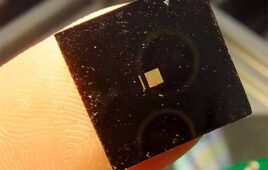
Cervical cancer cells (Image from National Cancer Institute\Winship Cancer Institute of Emory University)
Researchers have developed a computer algorithm that they say can analyze digital images of a woman’s cervix and accurately identify precancerous changes that require medical attention. This artificial intelligence approach, called automated visual evaluation, has the potential to revolutionize cervical cancer screening, particularly in low-resource settings.
Led by investigators from the National Institutes of Health and humanitarian tech investment fund Global Good, the researchers used comprehensive datasets to “train” a machine-learning algorithm to recognize patterns in complex visual inputs, such as medical images. The findings were confirmed independently by experts at the National Library of Medicine. The results appeared in the Journal of the National Cancer Institute (NCI).
“Our findings show that a deep-learning algorithm can use images collected during routine cervical cancer screening to identify precancerous changes that, if left untreated, may develop into cancer,” said senior author Mark Schiffman, M.D., in a prepared statement. “In fact, the computer analysis of the images was better at identifying precancer than a human expert reviewer of Pap tests under the microscope.”
To create the algorithm, the research team used more than 60,000 cervical images from an NCI archive of photos collected during a cervical cancer screening study that was carried out in Costa Rica in the 1990s. More than 9,400 women participated in that population study, with follow-up that lasted up to 18 years. Because of the prospective nature of the study, the researchers gained nearly complete information on which cervical changes became precancers and which did not. The photos were digitized and then used to train a deep-learning algorithm to distinguish cervical conditions requiring treatment from those not requiring treatment.
The new method could be particularly valuable in low-resource settings, where healthcare workers use a screening method called visual inspection with acetic acid (VIA), according to Schiffman, of NCI’s Division of Cancer Epidemiology and Genetics. In this approach, a health worker applies dilute acetic acid to the cervix and inspects the cervix with the naked eye, looking for “aceto whitening,” which indicates possible disease. Because of its convenience and low cost, VIA is widely used where more advanced screening methods are not available. However, it is known to be inaccurate and needs improvement.
Automated visual evaluation is similarly easy to perform. Health workers can use a cell phone or similar camera device for cervical screening and treatment during a single visit. This approach can also be performed with minimal training, making it ideal for countries with limited healthcare resources, where cervical cancer is a leading cause of illness and death among women.
“When this algorithm is combined with advances in HPV vaccination, emerging HPV detection technologies, and improvements in treatment, it is conceivable that cervical cancer could be brought under control, even in low-resource settings,” said Maurizio Vecchione, executive vice president of Global Good.
The researchers plan to further train the algorithm on a sample of representative images of cervical precancers and normal cervical tissue from women in communities around the world, using a variety of cameras and other imaging options. This step is necessary because of subtle variations in the appearance of the cervix among women in different geographic regions. The researchers’ ultimate goal is to create the best possible algorithm for common, open use.





Uganda is one of the countries in world with high burden of cervical cancer. 500000 are diagnosed each year & of which 273000 die.
80% come from rular areas & 85% are diagnosed late.
We have no screening services in all health facilities in Uganda.
Screening tests do not reach rular areas.
We are currently using traditional method of VIA for screening.
We are hence requesting to pioneer this innovation of using AI in cancer of cervix testing.
We shall hence give you feed back for comparison, evaluation & its impact
Hope to hear from you soon
Dr bahati amon